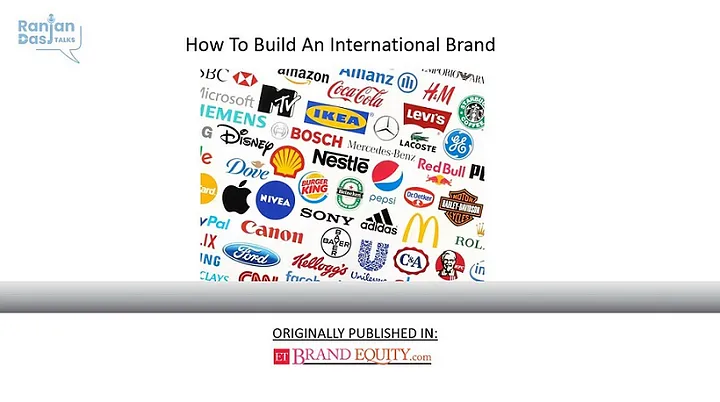
Blog
How to build an international brand
Many brands have strategized and changed their business models so as to adapt to the local situations in various countries to be accepted and these brands have now gained an international acclaim

Ranjan Das
· Posted: 2023-01-27
Posted: 2023-01-27

A substantial part of my mother’s youth was spent in waiting for her aunts who stayed in US and UK, as they would bring suitcases full of Wrigley’s, Mars, Bounty chocolates, Coca Cola cans, Levi’s, and a lot of ‘imported’ goods.
Globalisation changed this and now the same aunts carry back suitcases full of Sabyasachi, MDH masalas, jeans, and shoes that are available in India at reasonable prices.
Many brands have strategized and changed their business models so as to adapt to the local situations in various countries to be accepted and these brands have now gained an international acclaim and a solid customer base. However, shifting a brand overseas can be really challenging.
There are a different set of audience so there would be different set of assumptions and needs of the brand. Understanding this well to integrate in a foreign land is absolutely crucial.
If one is looking to create an international brand, it would serve them well to imbibe the following strategies-
1. Make sure you have a market or can create one- Knowing your target audience well, their current and possible future needs you can create is important. It helps in gaining an overall view of how you can market your business and imbibe core values when you go overseas. Despite being a ‘cold drink’ essentially, Coca-Cola is sold over 200 countries today, including all cold countries as well having 84000 suppliers the world over earning more than 70% of its income from non-US companies.
Subway Sells from over 2400 locations other than US & Canada, as a low — fat, Eat Fresh relatively ‘healthier’ fast food chain.
2. Make sure that you can deliver- You should make sure than you can deliver to the new market / country, efficiently without losing the brand promise. Investigate local laws and sentiments, understand the availability of raw materials. McDonald’s, before entering the Indian market, examined all these well.
They ensured they get potatoes prescribed for their famous French fries, specific quality of buns for their burgers and the menu was tailor developed catering to the Indian palette without pork and beef in any of their product line. Before any new franchisee of McDonald’s is approved, their supply chain must ensure they can cater to that location without fail the optimal quality of each ingredients the brand need to keep up with the brand promise.
3. Leverage technology- Technology has been the real disruptor but can be a key helping your brand expand internationally. Right from optimising every process of your brand like sourcing, supply chain management, human resource, manufacturing, packaging, marketing, consumer relations to scaling your business fast in a new country, technology give your brand the winning edge.
Big tech brands like Microsoft, Netflix and Amazon are supremely adept at establishing themselves in new territories. A study of how they do this highlights some important lessons that any business, large or small, can apply to its own expansion strategy. For any non-technology companies technological edge through remote Social Media Management, Smart Marketing, Cloud Computing, Big Data Analytics, VOIP, etc help become agile, expanding faster
4. Re-examine your product name- Before entering the global market, one should understand that the product name or the brand name will not hurt other peoples’ sentiments or will become a piece of joke. Choosing an apt name is vital before entering the international market. Lay’s changed their name and used local names when they acquired local business in their industry.
In the UK, they are called Walkers, in Australia they use the Smith’s brand for marketing reasons, and in Israel they use the name Tapuchips. Boost, a fresh fruit juice QSR chain from Australia when launched in India had to change the brand name to Joost as Boost already is a well know nutrition drinks for growing child in India. Quebec in Canada is primarily a French-speaking region of the country and thus has strict naming laws. Due to this, the almost universally known KFC is actually translated to ‘Poulet Frit Kentucky’, with the logo reflecting the acronym ‘PFK.
Another case of a fast-food chain having to reinvent its entire line of packaging is Burger King, who goes by the name of Hungry Jack’s down under. Australia already had a registered franchise known as Burger King, and thus the next logical step was, obviously, Hungry Jack’s.
5. Re-checking the logo- Logo design or image could strike a wrong chord in the consumers’ mind. So being culturally correct is important. Starbucks couldn’t have gone the conventional way like Coca Cola and make most of their audience happy with uniformity. Starbucks had to change their logo when they decided to move into a conservative culture, they removed their famous mermaid and decided to only keep her crown in Saudi Arabia.
They faced severe backlash for doing so. They were stuck between trying to match the societal expectations and trying to stick to their inherent values. That’s what happened to Dunkin Donuts when it expanded by all countries and found that in Spain, it could not keep its name because the word Donut was already registered by Panrico. So, they decided to change the name Dunkin Coffee and keep the logo as it was clearly recognizable.
6. Retaining brand identity- Before going international, brands tend to tune their brand image with the country’s culture. Understanding that changing the brand identity is acceptable but with the fear to lose your image also arises in the long run. Hence, holding tight to your core values and fundamentals is necessary. All this can be done by understanding your customers, keeping your roots intact, and educating your employees and audience.
Sales and marketing of Victoria’s Secret in Saudi Arabia is an insightful example of how the brand managed to strike a balance between the brands image and Saudi Arabia’s strict rules and expectations. Walkers is arguably the UK’s most-known, most-beloved crisps company, and yet the rest of the world decides to adapt the brand under a completely different identity. In North America, the brand flies different colours under the banner of ‘Lay’s’, Mexico calls it ‘Sabritas’ and South America goes even further with the enigmatic name of ‘Margarita’.
7. Understanding packaging requirements- When you’re selling a product, considering their laws and customs in the new market is important before you decide the packaging for the product. There are many factors like social and cultural expectations, government rules, local climate conditions, local transport & handling facilities, cost of raw material for packaging in that country, etc.
Packaging of Diet Coke, in many countries is replaced by ‘Coke Light’ as those countries don’t accept that a product simply having lower calories qualifies it as being part of a diet. Many will know Red Bull by their iconic silver cans with blue & red hints, yet in China they’ve gone in a completely different direction packaged in golden coloured cans with red bulls written in black.
8. Think global, act local- By deciding to go local, you can cater to specific audiences’ needs better. Understanding that- a broad perspective won’t work in specific regions, is of utmost importance like McDonalds did. McDonald’s has been one such brand which has adapted well in the local markets and is a local expert, so to say. They show respect to various cultures and stick to every country’s policy while developing their menu.
The biggest example for this is that despite them being strongly associated with selling beef in the West, as soon as they came to India, they stopped that practice. They did not sell beef or pork in India which very strongly indicates their power of adaptation. Energy drink Red Bull’s classic carbonated nature has been toned down in China to match local tastes.
After hitting 220.67 million paid subscribers worldwide in 190 countries the second quarter of 2022, Netflix is set out for even larger customer base and is aggressively undertook a localization program to curate local-language programming and content for customers in each country. That included rolling out programming with localized subtitles, local languages for its user interface, and dubbing to existing programs.
9. Work with non-market forces to have them by your side — Organizations exist in a complex ecosystem at the intersection of business, globalization, and public policy. Those executives who better understand the ways business are shaped by non-market factors — regulatory, legal, political, cultural and social forces and the relationships and interactions among firms, government, and the public — are better positioned to lead their organizations in a rapidly changing world.
Levi Strauss’ market strategy of extending markets and sourcing from throughout the world had resulted in some complicated non-market concerns. Its issue was figuring out how to align its supplier relationships with its ethical beliefs and operating standards. It was a source of concern for the corporation because its suppliers did not satisfy the same high requirements as its own production facilities.
At addition, Levi Strauss was concerned that conditions in its suppliers’ facilities relating to child labour, jail labour, plant safety, and environmental protection could harm the company’s brand. Human rights were also an issue for the corporation in the nations where its suppliers were based.
10. Rely on local experts across fields — Local expertise is valuable for organizations undertaking global expansion. If you can, hire local consulting brands, personnel or find experts who are familiar with your target market. Aside from their subject matter expertise, these experts can also help you understand important cultural differences and localization considerations you may have otherwise overlooked.
These local specialist consulting Brands can help you spot what all fields should I hire local experts in, what is their experience with this target market or culture, could this expert help my business build our global reputation and local trust are some of the question that you must screen your local help through. Puma was advised by local experts about Indian buying behaviour and how to design their products for the Indian customers moving away from only targeting sports attire and moving towards the fashion segment as well.
11. Choose expansion partner correctly for a long haul — Sometimes international brands face challenges with their expansion partners and it is advised that they choose their partners very carefully and have strict expectations of compliances, so as to not dilute their brand image. In the case of Gujarat Bottling Co. Ltd. vs. Coca Cola Co.; Coke had to file a case against the bottling company for breaching the agreement and entering into a contract with another beverage company.
Another unfortunate experience was faced by famous brands such as Burger King and Taco Bell in Nigeria, when these brands decided to expand their business into new territories, where they discovered that some parties were using their trademarks illegally. Hence, the correct partner will guide the brand to get the business registered in a franchise agreement to prevent unauthorised use of the trademarks.
12. Realizing location economies- Locating a value creation activity in the optimal location for that activity can have one of two effects: (1) it can lower the costs of value creation, helping the company achieve a low-cost position; or (2) it can enable a company to differentiate its product offering. Hindustan Unilever’s value creation model is based on growing the core, evolving the portfolio through innovations and market development.
Their idea to develop new channels in order to deliver long term growth and sustainable value creation, helps them attain an increased customer base and in turn lowers the cost of production.
Nestle for value creation has sharpened their Nutrition, Health, and Wellness strategy. They have started pursuing growth, margin and capital efficiency, and are focused on creating shared values. All these creations have helped them reach trading operating profit margin of 18.5% which was increased from 17.5% in 2020.
13. Choose the right mode of entry — Exporting, Licencing, Franchising, joint venture and wholly owned subsidiary are few of the most common routes available to for a brand to expand to a new country.
A brand should pace itself through this ladder, depending on the various factors like their size of market and investment funds available in home and target country, demand projection in target country, allied partner and their strengths, government regulations and over all potency of the opportunity. Walt Disney Entertainment holds 100% of Marvel Entertainment that produces movies, is an example of a wholly owned subsidiary.
14. Understand your local competition, price and position yourself well — Each country you are planning to expand has their own market and product dynamics aligned to local demand and expectations. The set of brands you compete in one country may be entirely different in a new country you are expanding to. Price points are equally deciding as in being successful or not. Work on your positioning and pricing in the new market/country well.
Zara to compete with other international brands provides lower prices in all its international stores. It follows a low pricing strategy and has a low cost structure as compared to its competitors. Moreover, its prices are country specific. Marks and Spencer along similar lines, follows a dynamic pricing strategy by offering huge discounts during seasonal times on older stock which is put on sale at a lesser price thus offering luxury brand products at a competitive pricing which the local retailers find difficult to match.
15. Take bigger risks while expanding- Companies should break free from their fear of taking risks. Without risks, sustenance in the international market would be tough. Calculated risks, where you have a good strategic plan, flexible ideas, and in-depth understanding of the market can take you places.
Starbucks faced a major challenge in different international markets like the Asian markets where coffee market was at a development stage, so to educate the masses about the quality, experience of coffee and to drive away idea of coffee from health concerns was tough. Pricing decision was another challenge that Starbucks faced as people in various developing countries have disposable income and economic situations where it’s difficult to be able to afford this brand.
The government’s actions affected Starbucks quite a lot with exchange control, trade agreements, trademarks, and various other foreign regulations which protected the farmers and their rights. But, they took calculated big risks in these markets, albeit did not go all in and managed to conquer the markets.
To sum it all, if one is looking at building an international brand it is important to be sensitive to local sentiments and cultural norms, be flexible, use cutting edge technology, and establish a brand identity that cashes on both local and global perspectives. Measuring each brand’s failure or success helps in expanding the business immensely. Critically analysing their weaknesses and the steps they took to get acclaimed internationally, is vital for the growth of a brand. Having a local expert to guide, pave way and local partners to expand in various roles are very useful
The author is the managing director at Apppl Combine. Views expressed are personal.
Marketing is everything, products are
woven around it.